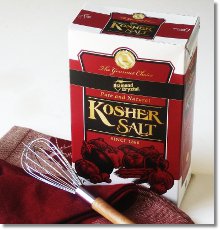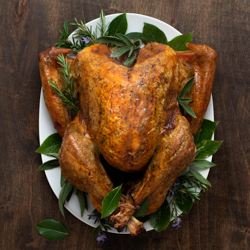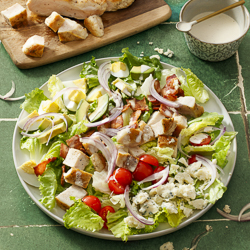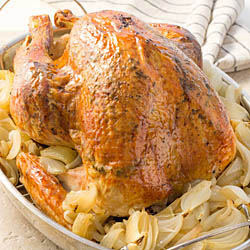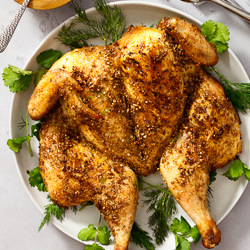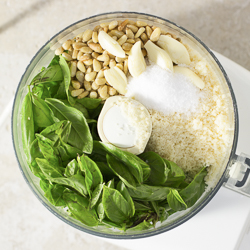Last year’s Thanksgiving post was about the hows and whys of brining. But it was a video. A seven-minute video. So I doubt you watched it.
My bad.
I don’t doubt, however, that brining will make a huge difference in your Thanksgiving turkey.
HUGE.
So I thought I’d ‘splain it again, but in a way that doesn’t take seven minutes of your time. Promise.
What is brining?
Brining is simply soaking food in a salt water solution. There’s brining for food production and preservation, like with olives or pickles, but there’s also brining to enhance the ultimate outcome of cooked proteins, like meat, fish, or poultry. That’s the kind of brining we’re talking about for turkey.
Why do it?
Brining helps make proteins more flavorful and juicy.
How does it work?
Through the magic of diffusion and osmosis, the salt solution gets into the meat, seasoning it, but also effecting the structure of the proteins such that they hold more liquid.
What should I brine?
Because brining helps make things flavorful and juicy, the best candidates are proteins that have a tendency to be bland and/or dry. Which means lean proteins and ones that require more thorough cooking. A chicken breast is a perfect example – its lack of fat means that it tends to be flavorless and dry. Chicken also needs to be cooked through, also making it tend to dry out. The same goes for some cuts of pork and leaner fishes.
What shouldn’t I brine?
I wouldn’t recommend brining beef or lamb. One, they tend to have more fat, which makes them inherently more flavorful. And two, we tend to enjoy them rarer, which means they’re less likely to dry out.
Anything else to think about when thinking about brining?
Just this – in addition to your protein, consider your cooking method. Cooking methods that tend to dry things out, like roasting and grilling, are good ones to pair with brining. With moist cooking methods, like braising or poaching, brining wouldn’t be worth the effort.
How do I make a brine?
Just whisk together salt and water.
How much?
My basic brine is 2 cups of water to 3 tablespoons coarse kosher salt (half as much if you use finely ground salt). For a turkey, that’s 2 gallons of water to 3 cups coarse kosher salt.
That’s it?
If you like, enhance your brine with sugar, aromatics (like onions and garlic), herbs (like sprigs of rosemary, thyme, or oregano), and spices (like whole peppercorns, star anise, or juniper berries).
The most amazingly simple and delicious turkey I ever made was just salt and sugar.
How long do I brine?
12 to 24 hours for a whole turkey.
But don’t limit yourself to once-a-year-brining for Thanksgiving. Brine shrimp or fish filets for an hour or 2. Brine chops, chicken breasts, and pork tenderloins for 4 to 6 hours. Brine a turkey breast for 8 to 12 hours.
Then what?
Remove the meat from the brine (discard the brine), pat it dry, and proceed with your recipe. It’s that easy, and it makes such a difference.
One last bit of encouragement…
A few years ago, I was working on a magazine recipe for a stuffed pork loin. I got the recipe just like I wanted it, but had some time before the project was due. So I made the pork exactly the same again, but brined. The difference was dramatic, especially since I had back-to-back comparisons. The meat was juicy, flavorful, and also had a more pleasantly toothsome texture.
I became a briner.
Join the club.
And have a very, very happy Thanksgiving.
